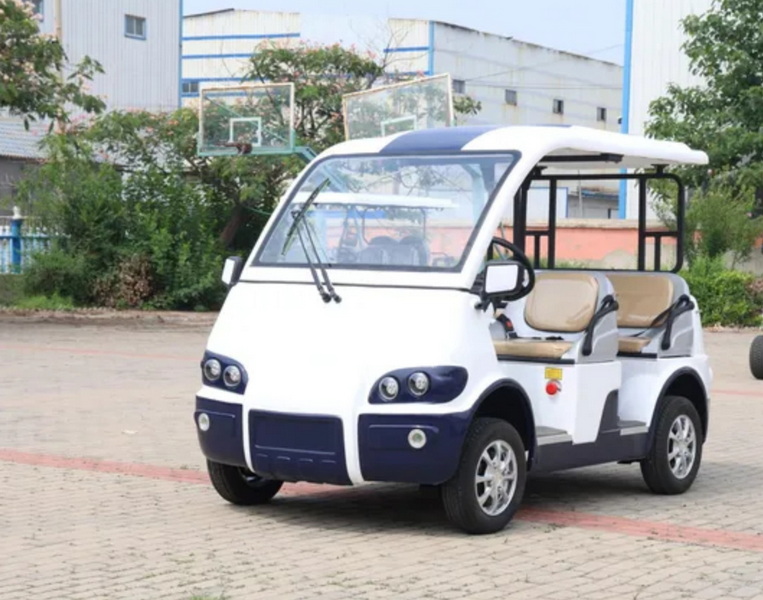Content Menu
● The Rise of Electric Patrol Carts in Community Policing
● Environmental and Social Benefits
>> Zero Emissions and Noise Reduction
>> Visual: Side-by-side comparison of emissions from a gasoline patrol vehicle versus an electric patrol cart.
>> Social Impact: Fostering a Healthier Community
● Enhancing Visibility and Approachability
>> Elevated Presence Without Intimidation
>> Encouraging Positive Interactions
● Cost Efficiency and Operational Advantages
>> Lower Operational Costs
>> Increased Patrol Coverage and Flexibility
>> Visual: Infographic showing cost comparison between electric patrol carts and traditional patrol vehicles over five years.
>> Operational Efficiency: Extended Patrol Hours
● Customization and Technological Integration
>> Tailored Features for Diverse Needs
>> Integrating Smart Technologies
● Community Engagement Through Sustainable Practices
>> Symbolizing Commitment to Green Initiatives
>> Educational Outreach and Collaboration
>> Building Trust Through Transparency
● Overcoming Challenges and Future Prospects
>> Addressing Range and Charging Infrastructure
>> Training and Change Management
>> Community Acceptance and Awareness
>> Future Innovations
● Conclusion
● FAQ
>> 1. What makes electric patrol carts more community-friendly than traditional patrol vehicles?
>> 2. How do electric patrol carts contribute to sustainability goals?
>> 3. Can electric patrol carts be customized for different security needs?
>> 4. Are electric patrol carts cost-effective compared to traditional vehicles?
>> 5. What challenges do agencies face when adopting electric patrol carts?
Electric patrol carts are transforming the way communities interact with law enforcement and security personnel. These eco-friendly, quiet, and versatile vehicles offer a new approach to patrolling that fosters trust, accessibility, and sustainability. This article explores the multifaceted benefits of electric patrol carts in enhancing community engagement, supported by visual and multimedia elements to illustrate their impact.

The Rise of Electric Patrol Carts in Community Policing
Electric patrol carts have gained popularity in various settings, including urban neighborhoods, campuses, parks, and event venues. Their compact size and silent operation allow officers to navigate tight spaces and sensitive environments without disturbing residents or visitors.
In many cities, traditional patrol vehicles—large, noisy, and sometimes intimidating—can create barriers between law enforcement and the public. Electric patrol carts, by contrast, are smaller and less imposing, encouraging more frequent and informal interactions between officers and community members. This shift in approach aligns with modern community policing philosophies that emphasize partnership, problem-solving, and proactive engagement.
Environmental and Social Benefits
Zero Emissions and Noise Reduction
Electric patrol carts operate on clean energy, producing zero tailpipe emissions. This significantly reduces the carbon footprint compared to traditional gasoline-powered vehicles, supporting global climate goals and improving urban air quality. In densely populated areas, reducing vehicle emissions is critical for public health, especially for vulnerable populations such as children, the elderly, and those with respiratory conditions.
Their quiet operation minimizes noise pollution, making them ideal for residential areas, hospitals, and campuses where maintaining a peaceful environment is crucial. The absence of engine noise also allows officers to be more discreet when necessary, enhancing their ability to monitor situations without causing alarm.
Visual: Side-by-side comparison of emissions from a gasoline patrol vehicle versus an electric patrol cart.
Social Impact: Fostering a Healthier Community
By reducing noise and air pollution, electric patrol carts contribute to creating healthier neighborhoods. Residents can enjoy outdoor spaces with less disturbance, and children playing in parks benefit from cleaner air. This environmental stewardship reflects a broader commitment to community well-being beyond traditional law enforcement duties.
Enhancing Visibility and Approachability
Elevated Presence Without Intimidation
Electric patrol carts often feature elevated seating, giving officers a better vantage point over crowds and obstacles. This height advantage improves situational awareness, allowing officers to spot potential issues early and respond promptly. However, unlike large patrol cars or SUVs, these carts maintain a friendly and open demeanor.
Encouraging Positive Interactions
The design of electric patrol carts encourages officers to engage with residents more frequently and comfortably. Without the barrier of a car door or window, officers can easily step off the vehicle to talk, listen, and build rapport. This accessibility helps break down social barriers and dispels fears or misconceptions about law enforcement.
Cost Efficiency and Operational Advantages
Lower Operational Costs
Electric patrol carts offer significant cost savings due to lower fuel and maintenance expenses. Electricity is cheaper and more stable in price than gasoline, and electric vehicles have fewer moving parts, reducing breakdowns and service needs. These savings can be substantial over the lifespan of the vehicle.
Increased Patrol Coverage and Flexibility
Because electric patrol carts are smaller and more maneuverable, officers can cover areas inaccessible to larger vehicles, such as pedestrian zones, narrow alleys, and indoor facilities. This flexibility enhances the overall effectiveness of patrol operations, allowing for more comprehensive coverage.
Visual: Infographic showing cost comparison between electric patrol carts and traditional patrol vehicles over five years.
Operational Efficiency: Extended Patrol Hours
Many electric patrol carts come with long-lasting batteries and fast-charging capabilities, enabling extended patrol hours without frequent downtime. This reliability ensures that officers remain visible and active in the community during peak times, further strengthening engagement.
Customization and Technological Integration
Tailored Features for Diverse Needs
Electric patrol carts can be customized with a variety of features to meet specific operational requirements. These include:
- LED emergency lights and sirens for visibility and alerting
- Loudspeakers for public announcements and crowd control
- Communication systems for real-time coordination
- Storage compartments for first aid kits, evidence collection, or community outreach materials
- Weather protection such as canopies or enclosed cabins for all-season use
Integrating Smart Technologies
Modern electric patrol carts can be equipped with advanced technologies such as GPS tracking, body cameras, and mobile data terminals. These tools enhance transparency, accountability, and situational awareness, enabling officers to respond more effectively and document incidents accurately.

Community Engagement Through Sustainable Practices
Symbolizing Commitment to Green Initiatives
The adoption of electric patrol carts sends a powerful message about a law enforcement agency's dedication to sustainability and community health. This visible commitment resonates with environmentally conscious residents and community groups, fostering a shared sense of responsibility.
Educational Outreach and Collaboration
Many agencies use electric patrol carts as part of community education programs, showcasing their features and benefits during public events, school visits, and workshops. These initiatives provide opportunities for dialogue, allowing residents to ask questions, express concerns, and learn about broader sustainability efforts.
Building Trust Through Transparency
By openly sharing information about their green practices and involving the community in decision-making, law enforcement agencies can build deeper trust and cooperation. This collaboration strengthens the social fabric and supports safer, more resilient neighborhoods.
Overcoming Challenges and Future Prospects
Addressing Range and Charging Infrastructure
One common concern with electric patrol carts is their operational range and the availability of charging stations. Agencies can mitigate these issues by strategically placing charging points at key locations such as precincts, community centers, and public parking areas.
Training and Change Management
Transitioning to electric patrol carts requires training officers on vehicle operation, maintenance, and new technologies. Change management strategies, including pilot programs and feedback sessions, help ease adoption and build confidence among personnel.
Community Acceptance and Awareness
Initial skepticism from both officers and residents can be addressed through transparent communication and demonstration projects. Highlighting success stories and tangible benefits encourages wider acceptance.
Future Innovations
Advancements in battery technology, such as solid-state batteries, promise longer ranges and faster charging times. Integration with AI-powered analytics and smart city infrastructure will enable electric patrol carts to become even more effective tools for community safety and engagement.
Conclusion
Electric patrol carts are more than just vehicles; they are catalysts for enhanced community engagement. Their environmental benefits, cost efficiency, and approachable design enable law enforcement to build stronger relationships with the communities they serve. By embracing these innovative tools, agencies demonstrate a commitment to sustainability, safety, and partnership, paving the way for a more connected and harmonious future. As technology and infrastructure continue to evolve, electric patrol carts will play an increasingly vital role in shaping responsive, inclusive, and eco-friendly community policing.

FAQ
1. What makes electric patrol carts more community-friendly than traditional patrol vehicles?
Electric patrol carts operate quietly and produce no emissions, reducing noise and air pollution. Their smaller size and approachable design encourage positive interactions between officers and community members, making law enforcement more accessible.
2. How do electric patrol carts contribute to sustainability goals?
They run on clean electricity, producing zero tailpipe emissions, which helps reduce the carbon footprint of law enforcement operations and supports broader environmental initiatives aimed at improving urban air quality.
3. Can electric patrol carts be customized for different security needs?
Yes, they can be equipped with sirens, LED lights, communication systems, storage compartments, and other features tailored to specific operational requirements, enhancing their versatility and effectiveness.
4. Are electric patrol carts cost-effective compared to traditional vehicles?
Yes, they have lower fuel and maintenance costs, fewer mechanical parts prone to failure, and benefit from stable electricity prices, resulting in significant long-term savings for law enforcement agencies.
5. What challenges do agencies face when adopting electric patrol carts?
Challenges include range limitations, charging infrastructure development, initial resistance within law enforcement, and the need for training. These can be addressed through strategic planning, community engagement, and technological advancements.










































